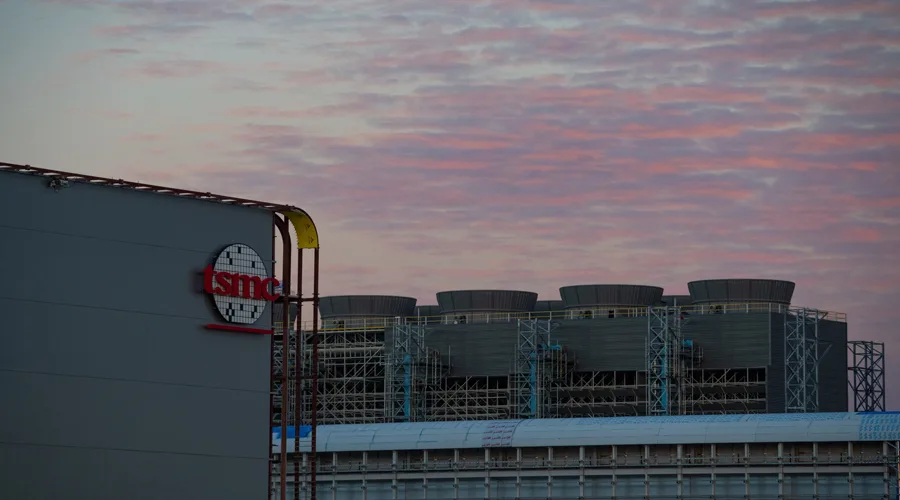Taiwan Semiconductor Manufacturing Company (TSMC), the global chipmaking giant, has recently declared a setback in the construction timeline of its second factory in Arizona, dealing a blow to US President Joe Biden’s plans to bolster American manufacturing. Initially slated for completion by 2026, TSMC Chairman Mark Liu revealed that the facility is now expected to be operational by 2027 or 2028.
While the construction of the factory’s shell has already commenced, TSMC is pausing to reassess the incentives offered by the US government before moving forward. Discussions with US officials are underway, primarily focusing on tax credits and other incentives crucial for the semiconductor powerhouse. This marks the second instance of TSMC altering its plans in Arizona, with the first fab’s production schedule being pushed back from 2024 to 2025 due to a shortage of skilled workers.
Moreover, there is speculation that TSMC might reconsider the types of products manufactured in the second factory. While the initial plan was centered around producing 3-nanometer chips, Liu hinted that the scale of government incentives would play a pivotal role in determining the technology deployed. Meanwhile, the first facility in Arizona remains on track to produce 4-nanometer chips, scheduled to kick off production in the first half of 2025.
TSMC, headquartered in Taiwan, holds a dominant position, being responsible for approximately 90% of the world’s super-advanced semiconductors. The company caters to major tech players like Apple and Nvidia. Despite traditionally keeping its most advanced manufacturing in Taiwan, TSMC has expanded globally, responding to commercial pressure and government encouragement. Recently, TSMC unveiled plans for its first factory in Europe, situated in Dresden, Germany, and is contemplating a second facility in Japan.
Although TSMC faced challenges in 2023 due to a weakening global economy, the company is optimistic about its prospects in 2024. TSMC foresees a 20% increase in revenue, attributing it to the growing demand for generative AI-related applications. The positive outlook has resonated with investors, leading to a significant uptick in TSMC’s shares following the earnings report.
In summary, TSMC’s decision to delay the construction of its second factory in Arizona poses challenges for US manufacturing and President Biden’s manufacturing initiatives. The ongoing review of government incentives and potential shifts in product plans underscore the intricate nature of global manufacturing decisions. Despite these challenges, TSMC remains upbeat about its future growth, anticipating a positive trajectory in the coming year.
🚨 #TSMC Chairman Mark Liu announces potential delays in Arizona factory production schedule! 🏭 The commencement date might be pushed to 2025 from the initially planned end of 2024. #Taiwanhttps://t.co/iFDt6de66R
— TVBS World Taiwan (@tvbsworldtaiwan) July 20, 2023
These companies and entities play a crucial role in the narrative of TSMC’s expansion, manufacturing decisions, and the broader implications for the semiconductor industry and the global economy.
- Taiwan Semiconductor Manufacturing Company (TSMC): The world’s largest chipmaker facing delays in the construction of its second factory in Arizona.
- Apple: One of the major tech companies supplied by TSMC.
- Nvidia: Another major tech company that relies on TSMC for semiconductor supply.
- US Government: Engaged in discussions with TSMC regarding incentives for the Arizona factory.
- TSMC’s Competitors: Implicitly referenced, as TSMC is making global expansion decisions in response to commercial pressure and government encouragement.
- Dresden, Germany: Mentioned as the location of TSMC’s first factory in Europe.
- Japan: Considered as a potential location for TSMC’s second facility.
- US President Joe Biden: Efforts to boost American manufacturing are affected by the delay in TSMC’s Arizona factory.
Taiwan Semiconductor Manufacturing Company (TSMC) recently announced a delay in the completion of its second factory in Arizona, adding a layer of complexity to the landscape of semiconductor manufacturing. While the article provides valuable insights, several key elements could enhance the depth and completeness of the coverage:
- Reasons for Construction Delay: To offer a more comprehensive understanding, delving into the specific reasons behind the delay is crucial. Exploring challenges in the supply chain, logistical hurdles, and any external factors affecting the construction timeline would provide readers with a more nuanced perspective.
- Detailed Government Incentives: While the article mentions TSMC’s discussions with the US government regarding tax credits and incentives, providing more specific details about the nature and extent of these incentives would shed light on the negotiations’ intricacies and potential impacts on TSMC’s decision-making.
- Insights into TSMC’s Decision-Making Process: A deeper exploration of TSMC’s decision-making process, including the factors considered and potential implications of reconsidering the initially planned 3-nanometer chip production, would add valuable insights into the company’s strategic thinking.
- Global Expansion Strategy: In addition to mentioning TSMC’s recent expansion in Europe and potential plans for a facility in Japan, offering details about the company’s broader global expansion strategy would provide context. What criteria does TSMC consider when selecting new locations, and how does this align with its overarching business strategy?
- Impact on Local Economy: Exploring the potential impact of the construction delay on the local Arizona economy would provide a more localized perspective. This could include insights into job creation, economic contributions, and collaborations with local businesses.
- Competitor Landscape: Incorporating information about TSMC’s main competitors and analyzing how this delay might influence the competitive landscape of the semiconductor industry would offer readers a more holistic view of the market dynamics.
- Environmental and Sustainability Considerations: Given the contemporary focus on environmental sustainability, providing information on how TSMC integrates sustainability into its construction plans would add a relevant and crucial dimension to the narrative.

